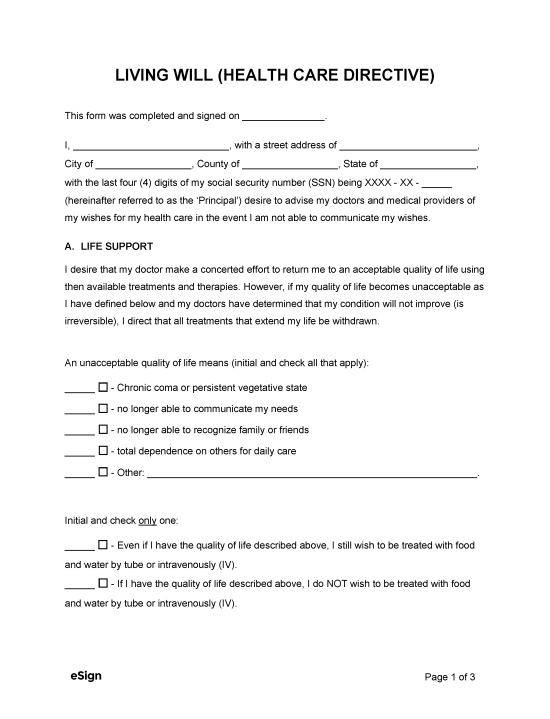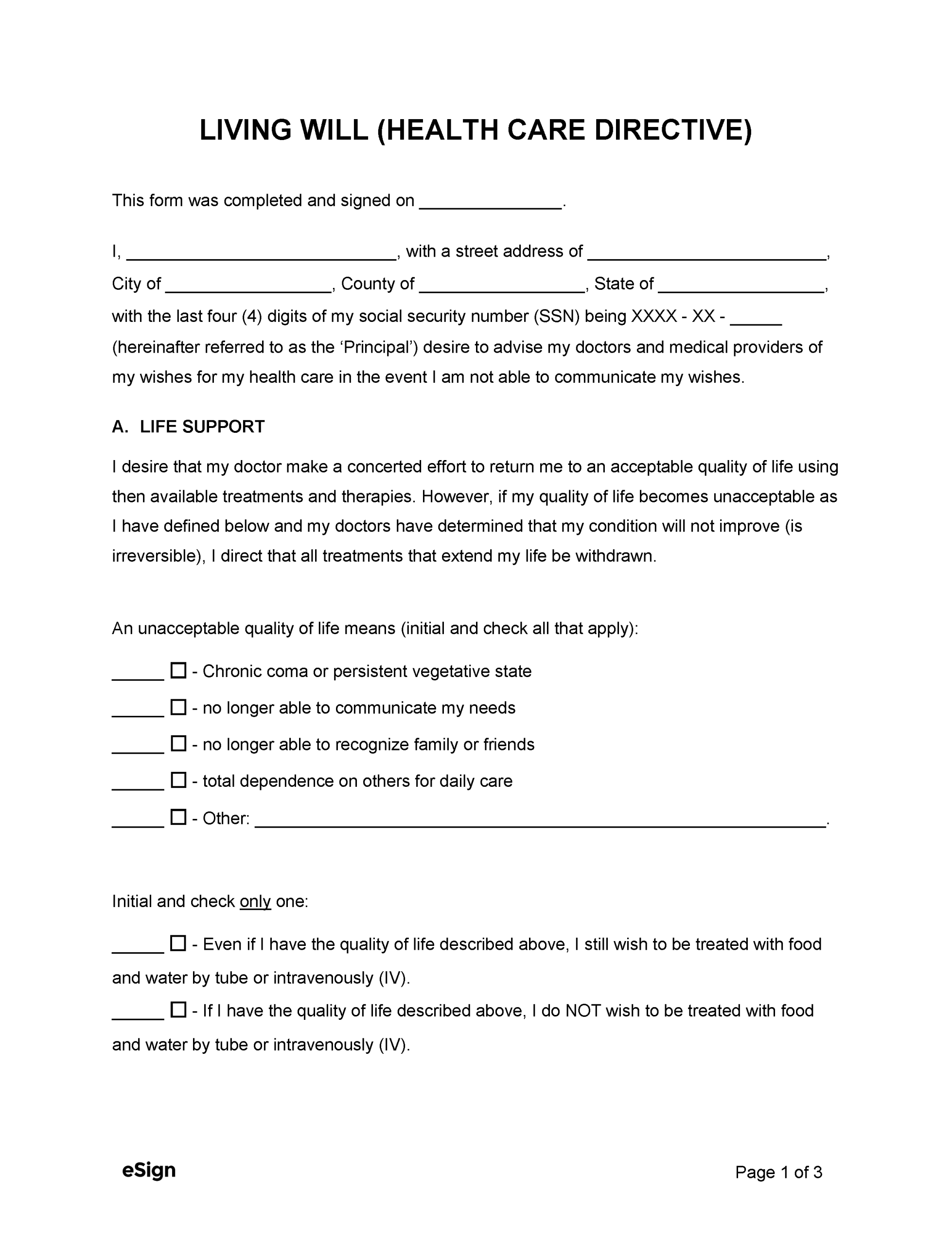Document Features
- Life Support – Communicates whether or not the principal wishes to receive life support in certain medical circumstances (coma, vegetative state, etc.).
- Life-Sustaining Measures – Prevents the principal from receiving CPR and other treatments to resuscitate them, if that is their choice.
- Additional Instructions – Describes the principal’s wishes regarding end-of-life treatments, hospice, spiritual preferences, and funeral arrangements.
Also Known As
- Health Care Directive
- Directive to Physicians
- Medical Directive
By State
- Alabama
- Alaska
- Arizona
- Arkansas
- California
- Colorado
- Connecticut
- Delaware
- Florida
- Georgia
- Hawaii
- Idaho
- Illinois
- Indiana
- Iowa
- Kansas
- Kentucky
- Louisiana
- Maine
- Maryland
- Massachusetts
- Michigan
- Minnesota
- Mississippi
- Missouri
- Montana
- Nebraska
- Nevada
- New Hampshire
- New Jersey
- New Mexico
- New York
- North Carolina
- North Dakota
- Ohio
- Oklahoma
- Oregon
- Pennsylvania
- Rhode Island
- South Carolina
- South Dakota
- Tennessee
- Texas
- Utah
- Vermont
- Virginia
- Washington
- West Virginia
- Wisconsin
- Wyoming
Living Will Definition
Living Will vs Living Trust
Living Will
- Written instructions for end-of-life care
- Only comes into effect when incapacitated and unable to communicate
- Does not cover a person’s estate
Living Trust
- Financial document for estate planning
- Creates an account that holds a person’s property during their lifetime
- After death, the trust is distributed as per the principal’s instructions
Will vs Living Will
Last Will and Testament
- Instructions for estate distribution
- Does not contain health care instructions
- Comes into effect only after the principal’s death
Living Will
- End-of-life health care preferences
- Only medical matters, not estate distribution
- Terminates upon principal’s death
How to Make a Living Will
Step 1 – Download Form
Because each state has different laws governing health care directives, the appropriate state form should be used to create a valid living will.
Step 2 – Determine Preferences

The principal must complete the form and select their preferred health care measures, such as life support, life-sustaining treatments, and end-of-life wishes.
Step 3 – Sign and Distribute
The principal must sign the form to make it legally binding. Depending on state requirements, witnesses or a notary public may need to sign the form as well.
The principal should retain a copy of their living will and deliver copies to their physician, health care agent (if applicable), and trusted family members.
Sample
LIVING WILL
(HEALTH CARE DIRECTIVE)
This form was completed and signed on [MM/DD/YYYY].
I, [PRINCIPAL NAME], with a street address of [PRINCIPAL ADDRESS], city of [PRINCIPAL CITY], county of [PRINCIPAL COUNTY], state of [PRINCIPAL STATE], with the last four digits of my social security number (SSN) being [####] (hereinafter referred to as the “Principal”) desire to advise my doctors and medical providers of my wishes for my health care in the event I am not able to communicate my wishes.
A. LIFE SUPPORT. I desire that my doctor make a concerted effort to return me to an acceptable quality of life using available treatments and therapies. However, if my quality of life becomes unacceptable as I have defined below and my doctors have determined that my condition will not improve (is irreversible), I direct that all treatments that extend my life be withdrawn.
An unacceptable quality of life means (initial and check all that apply):
[INITIALS] ☐ – Chronic coma or persistent vegetative state
[INITIALS] ☐ – No longer able to communicate my needs
[INITIALS] ☐ – No longer able to recognize family or friends
[INITIALS] ☐ – Total dependence on others for daily care
[INITIALS] ☐ – Other: [LIST OTHER UNACCEPTABLE QUALITY OF LIFE SITUATIONS]
Initial and check only one:
[INITIALS] ☐ – Even if I have the quality of life described above, I still wish to be treated with food and water by tube or intravenously (IV).
[INITIALS] ☐ – If I have the quality of life described above, I do NOT wish to be treated with food and water by tube or intravenously (IV).
B. CERTAIN LIFE-SUSTAINING TREATMENT. Some people do not wish to have certain life-sustaining treatments under any circumstance, even if recovery is a possibility. Check and initial beside treatments below, if any, that you do not wish to have under any circumstances:
[INITIALS] ☐ – Cardiopulmonary Resuscitation (CPR)
[INITIALS] ☐ – Ventilation (breathing machine)
[INITIALS] ☐ – Feeding tube
[INITIALS] ☐ – Dialysis
[INITIALS] ☐ – Other: [LIST OTHER LIFE-SUSTAINING TREATMENTS]
C. END OF LIFE WISHES. When I am near death, it is important to me that: [LIST END-OF-LIFE WISHES]
I have signed this document on [MM/DD/YYYY].
Principal Signature: ________________________
Print Name: [PRINTED NAME]
WITNESS ACKNOWLEDGMENT
On the date set forth above, I hereby state as follows:
The above-named person is personally known to me, and I believe him/her to be of sound mind and to have voluntarily executed this document. I am at least 18 years old and not related to him/her by blood, marriage, or adoption. To my knowledge, I am not a beneficiary of his/her will or any codicil, and I have no claim against his/her estate. I am not directly involved in his/her health care.
Witness 1 Signature: ________________________ Date: [MM/DD/YYYY]
Print Name: [PRINTED NAME]
Address: [ADDRESS]
Phone Number: [PHONE NUMBER]
Witness 2 Signature: ________________________ Date: [MM/DD/YYYY]
Print Name: [PRINTED NAME]
Address: [ADDRESS]
Phone Number: [PHONE NUMBER]



